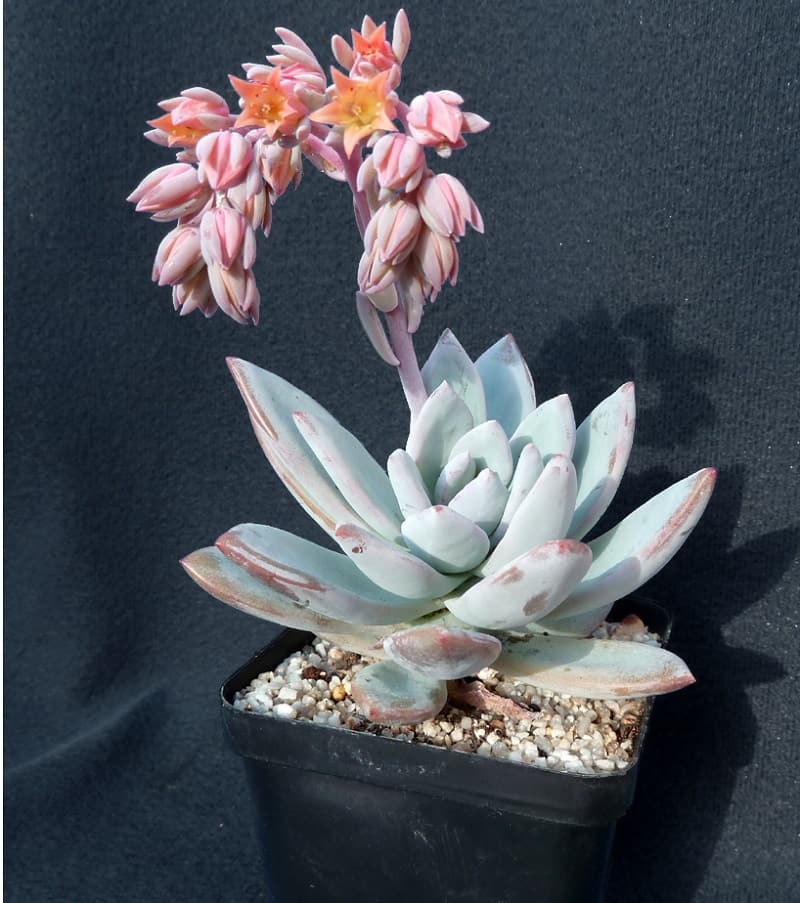Pachyveria ‘Powder Puff’ grows well in container gardens and hanging baskets.
It is a hybrid of Echeveria cante and Pachyphytum oviferum.
It has silver-blue leaves that have pink tips when grown in full sun.
Watch for orangish-pink flowers in mature plants.
Pachyveria ‘Powder Puff’ is a very unique group of plants, since they are hybrids of Echeveria x Pachyphytum.
Thus, they have characteristics of both genera, but although there are several types, there are actually only three accepted species, which are P. albomucronata, P. paradoxa and P. sempervivoides.
In spite of that, they are so decorative and easy to care for plants that in fact they only need a land with good drainage, lots of sun and little water.
This is a relatively new genre, so much so that it was not until 1926 when it was described.
They are characterized by forming rosettes composed of thick and fleshy leaves, almost cylindrical in some varieties, of colors that can be gray-blue or pink.
The flowers sprout in spring, in hanging clusters and are orange.
They do not require any special care, so they are highly recommended for beginners.
Of course, it is very important that they are in sunny places, that they are protected from frost, and that they are irrigated from time to time but avoiding pooling.
In this sense, and to avoid problems, it is advisable to use substrates with good drainages, such as black peat mixed with perlite in equal parts, pomice or river sand with 30% black peat, or even akadama if you live in a very climate rainy.
Tips to take care Pachyveria ‘Powder Puff’
Illumination
The plant prefers bright lighting, but with the shade of direct sunlight during the midday hours.
It is recommended to grow under protective meshes.
In temperate countries, it can be kept in the sun as long as the temperatures do not exceed 20 ° C.
In shady conditions, growth is disproportionate and weak, considerably affecting the aesthetics of the plant.
Temperature
It grows very well in hot climates with average temperatures between 20-35 ° C.
It is susceptible to rotting of stems and roots if temperatures are below 5 ° C approximately.
If grown indoors during winter, give the plant as much light as possible.
Watering
The Pachyveria ‘Powder Puff’ is a desert plant with few water needs.
The plant needs occasional watering from autumn to spring. and must drain any excess water.
Being accustomed to droughts, it accumulates a necessary water reserve between its leaves.
Therefore, with your irrigation, you have to be very careful.
In order not to be mistaken, it is best to focus on the state of the soil.
Wait until the soil is dry between irrigation and irrigation.
Substratum
Pachyveria ‘Powder Puff’ plants can tolerate and even thrive in poor soil conditions, provided the soil drains well.
This succulent grows well in neutral or slightly acidic friable soils with low nutrient content.
The required soil mixture can be prepared independently by mixing the soil prepared for cacti and succulents, which is sold in a flower shop, with thick river sand and fine gravel in a ratio of 3: 1: 1
Transplant
Transplanted plants do not need fertilizer for six to eight weeks.
The transplantation of these succulent plants should be done from late winter to early spring.
Keep the pot size the same or a size larger than the old container, since the little Pachyphytum jewel grows less than a foot tall.
Since, larger containers will retain excess water, which is harmful to the plant.
During the transplant, handle succulents carefully, as their leaves can easily fall off the stem.
Propagation
The Pachyveria ‘Powder Puff’ spreads easily from leaf cuttings:
- Take a young leaf from the center of the rosette.
- Allow the leaf to dry in the air for a few days for the wound to heal
- Dip the leaf cut into a rooting hormone.
- Place the leaf with the cut side down in a slightly damp succulent soil, cactus mix or slightly damp sand.
- Soon a new rosette will start growing from the base of the leaf.
- As soon as the succulent grows enough roots, remove the original cut of the leaf and return the rosette in its pot.
Plagues and diseases
It can be attacked by mealybugs (sometimes very difficult to remove because they are introduced between the compact leaves), aphids and mollusks (snails and slugs).
Be very careful with the latter because they can devour much of your plant in a few hours.
The succulent is quite resistant.
However, they are sensitive to human touch, since human skin oils can damage their fluorescent or farin color.
If the growth of your succulent plant seems to have stopped during winter or spring, remove the plant from the pot and examine the junctions of its leaves, stems, and roots.
If you see a white and blurred substance, it is a sure sign of a mealybug infestation.
To solve the problem, remove the plant from its pot and wash the roots of the plant gently.
Use a cotton swab to gently rub the alcohol on the roots.
Remove damaged roots with sterile scissors or a knife and allow the succulent to dry completely before transplanting.
If your succulent looks unhealthy without cause, one of the most common reasons is root rot due to excessive watering.
If the soil is too wet, replace it immediately instead of waiting for it to dry.
